CAMECO: Analysis of Global Business Impact and Strategic Direction
VerifiedAdded on 2020/11/23
|8
|2043
|410
Report
AI Summary
This report provides a detailed analysis of CAMECO's global business operations, focusing on the impact of global leadership, culture, and organizational structure. It explores the influence of ethical and sustainable globalization on organizational functions, including decision-making processes. The...
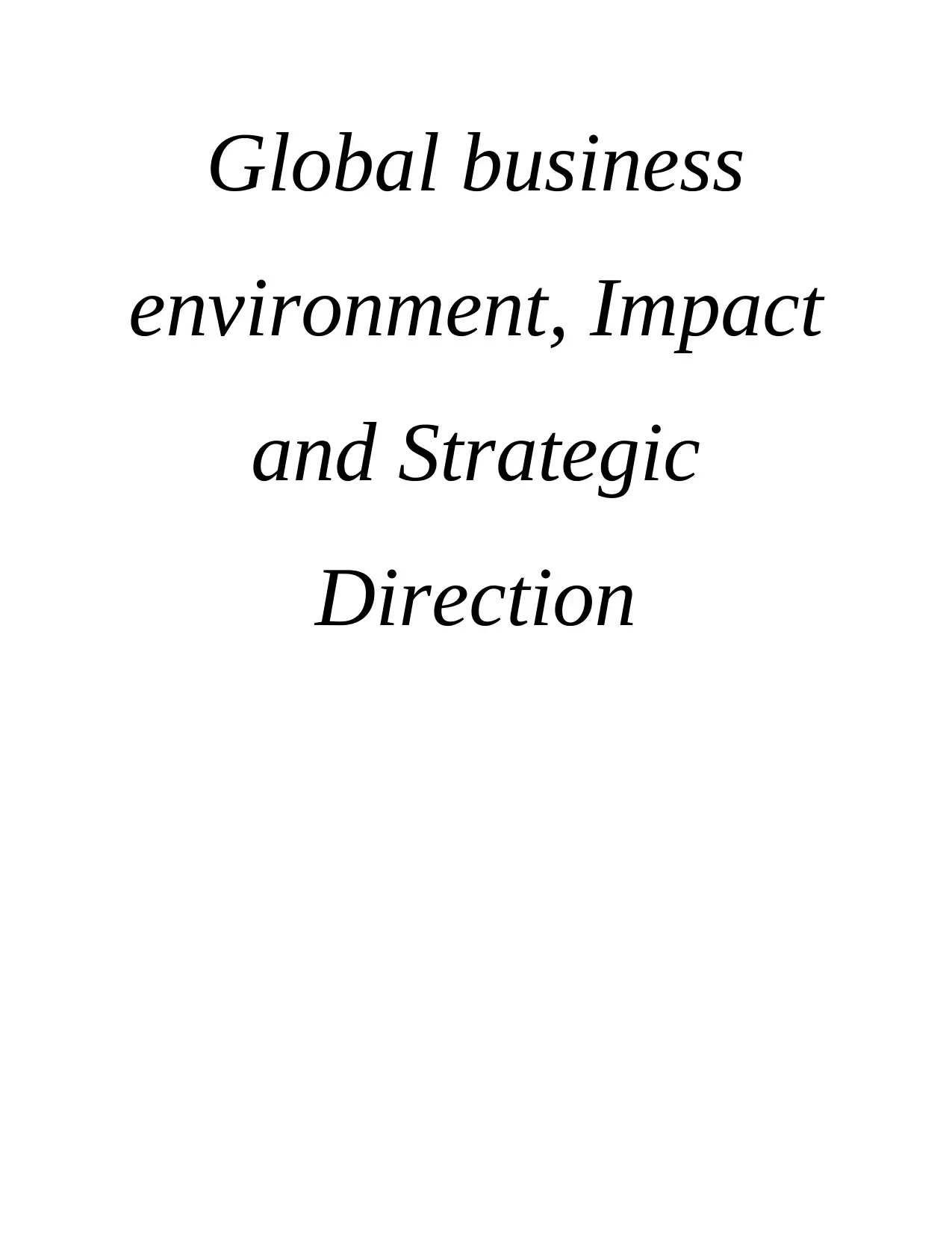
Global business
environment, Impact
and Strategic
Direction
environment, Impact
and Strategic
Direction
Paraphrase This Document
Need a fresh take? Get an instant paraphrase of this document with our AI Paraphraser
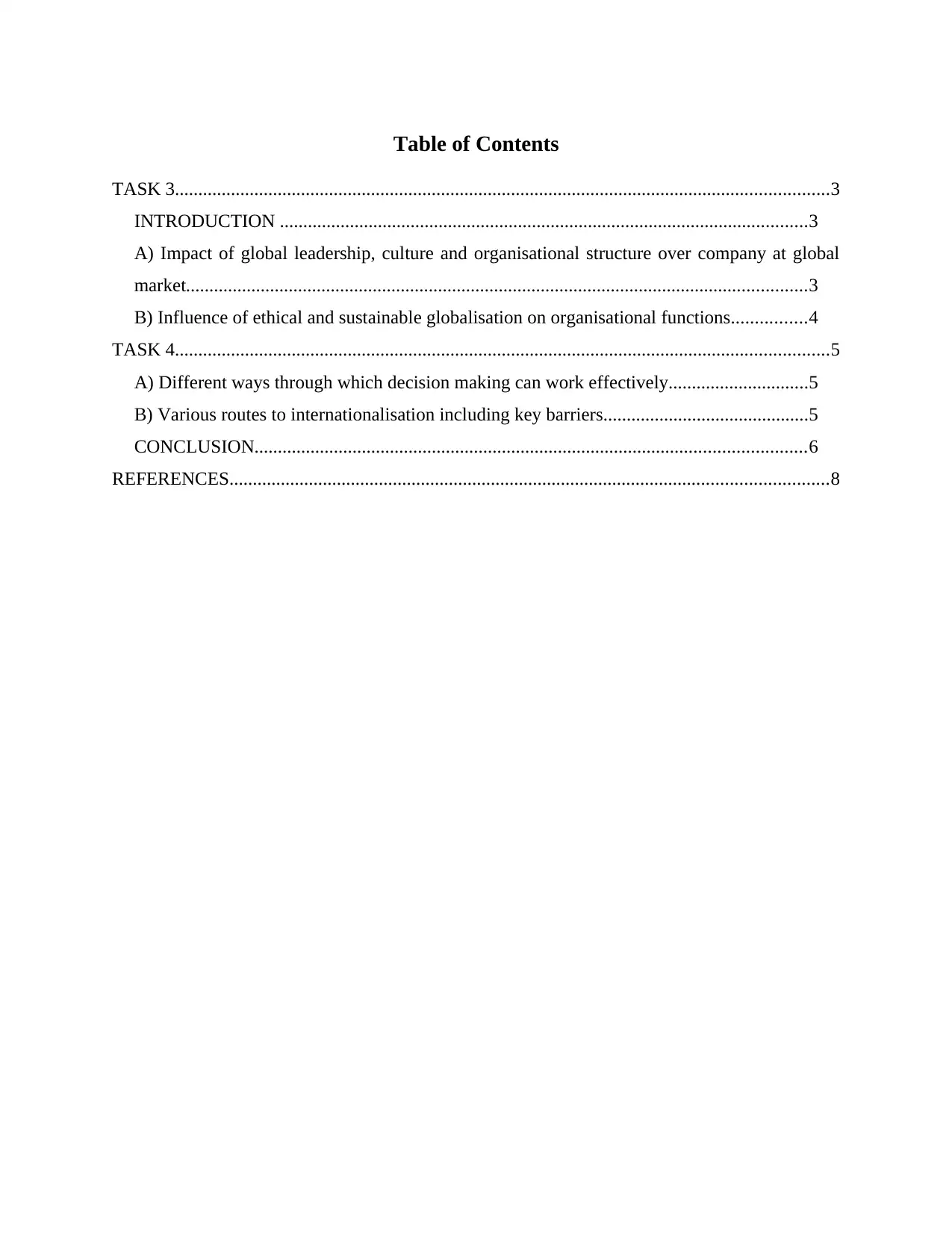
Table of Contents
TASK 3............................................................................................................................................3
INTRODUCTION .................................................................................................................3
A) Impact of global leadership, culture and organisational structure over company at global
market.....................................................................................................................................3
B) Influence of ethical and sustainable globalisation on organisational functions................4
TASK 4............................................................................................................................................5
A) Different ways through which decision making can work effectively..............................5
B) Various routes to internationalisation including key barriers............................................5
CONCLUSION......................................................................................................................6
REFERENCES................................................................................................................................8
TASK 3............................................................................................................................................3
INTRODUCTION .................................................................................................................3
A) Impact of global leadership, culture and organisational structure over company at global
market.....................................................................................................................................3
B) Influence of ethical and sustainable globalisation on organisational functions................4
TASK 4............................................................................................................................................5
A) Different ways through which decision making can work effectively..............................5
B) Various routes to internationalisation including key barriers............................................5
CONCLUSION......................................................................................................................6
REFERENCES................................................................................................................................8
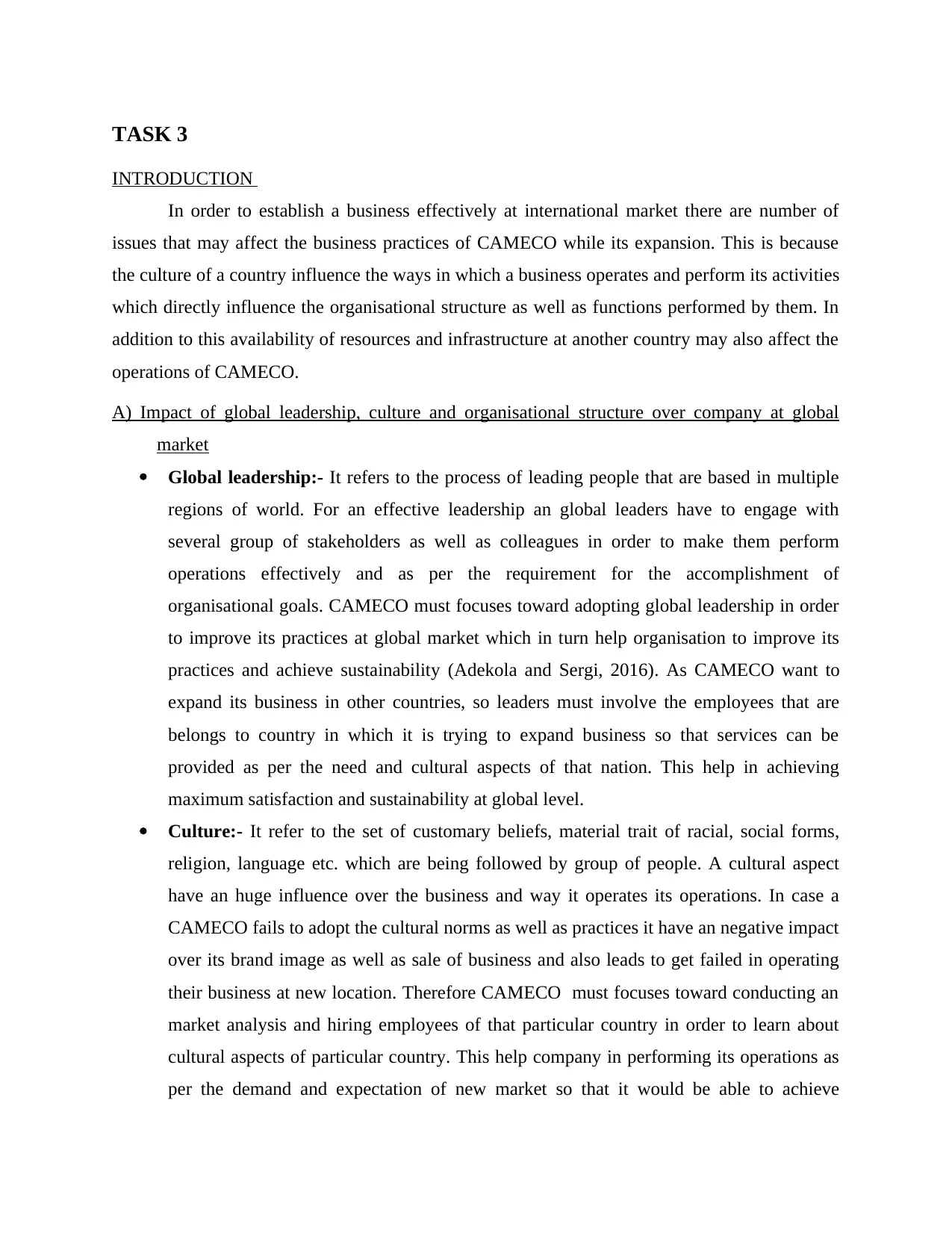
TASK 3
INTRODUCTION
In order to establish a business effectively at international market there are number of
issues that may affect the business practices of CAMECO while its expansion. This is because
the culture of a country influence the ways in which a business operates and perform its activities
which directly influence the organisational structure as well as functions performed by them. In
addition to this availability of resources and infrastructure at another country may also affect the
operations of CAMECO.
A) Impact of global leadership, culture and organisational structure over company at global
market
Global leadership:- It refers to the process of leading people that are based in multiple
regions of world. For an effective leadership an global leaders have to engage with
several group of stakeholders as well as colleagues in order to make them perform
operations effectively and as per the requirement for the accomplishment of
organisational goals. CAMECO must focuses toward adopting global leadership in order
to improve its practices at global market which in turn help organisation to improve its
practices and achieve sustainability (Adekola and Sergi, 2016). As CAMECO want to
expand its business in other countries, so leaders must involve the employees that are
belongs to country in which it is trying to expand business so that services can be
provided as per the need and cultural aspects of that nation. This help in achieving
maximum satisfaction and sustainability at global level.
Culture:- It refer to the set of customary beliefs, material trait of racial, social forms,
religion, language etc. which are being followed by group of people. A cultural aspect
have an huge influence over the business and way it operates its operations. In case a
CAMECO fails to adopt the cultural norms as well as practices it have an negative impact
over its brand image as well as sale of business and also leads to get failed in operating
their business at new location. Therefore CAMECO must focuses toward conducting an
market analysis and hiring employees of that particular country in order to learn about
cultural aspects of particular country. This help company in performing its operations as
per the demand and expectation of new market so that it would be able to achieve
INTRODUCTION
In order to establish a business effectively at international market there are number of
issues that may affect the business practices of CAMECO while its expansion. This is because
the culture of a country influence the ways in which a business operates and perform its activities
which directly influence the organisational structure as well as functions performed by them. In
addition to this availability of resources and infrastructure at another country may also affect the
operations of CAMECO.
A) Impact of global leadership, culture and organisational structure over company at global
market
Global leadership:- It refers to the process of leading people that are based in multiple
regions of world. For an effective leadership an global leaders have to engage with
several group of stakeholders as well as colleagues in order to make them perform
operations effectively and as per the requirement for the accomplishment of
organisational goals. CAMECO must focuses toward adopting global leadership in order
to improve its practices at global market which in turn help organisation to improve its
practices and achieve sustainability (Adekola and Sergi, 2016). As CAMECO want to
expand its business in other countries, so leaders must involve the employees that are
belongs to country in which it is trying to expand business so that services can be
provided as per the need and cultural aspects of that nation. This help in achieving
maximum satisfaction and sustainability at global level.
Culture:- It refer to the set of customary beliefs, material trait of racial, social forms,
religion, language etc. which are being followed by group of people. A cultural aspect
have an huge influence over the business and way it operates its operations. In case a
CAMECO fails to adopt the cultural norms as well as practices it have an negative impact
over its brand image as well as sale of business and also leads to get failed in operating
their business at new location. Therefore CAMECO must focuses toward conducting an
market analysis and hiring employees of that particular country in order to learn about
cultural aspects of particular country. This help company in performing its operations as
per the demand and expectation of new market so that it would be able to achieve
You're viewing a preview
Unlock full access by subscribing today!
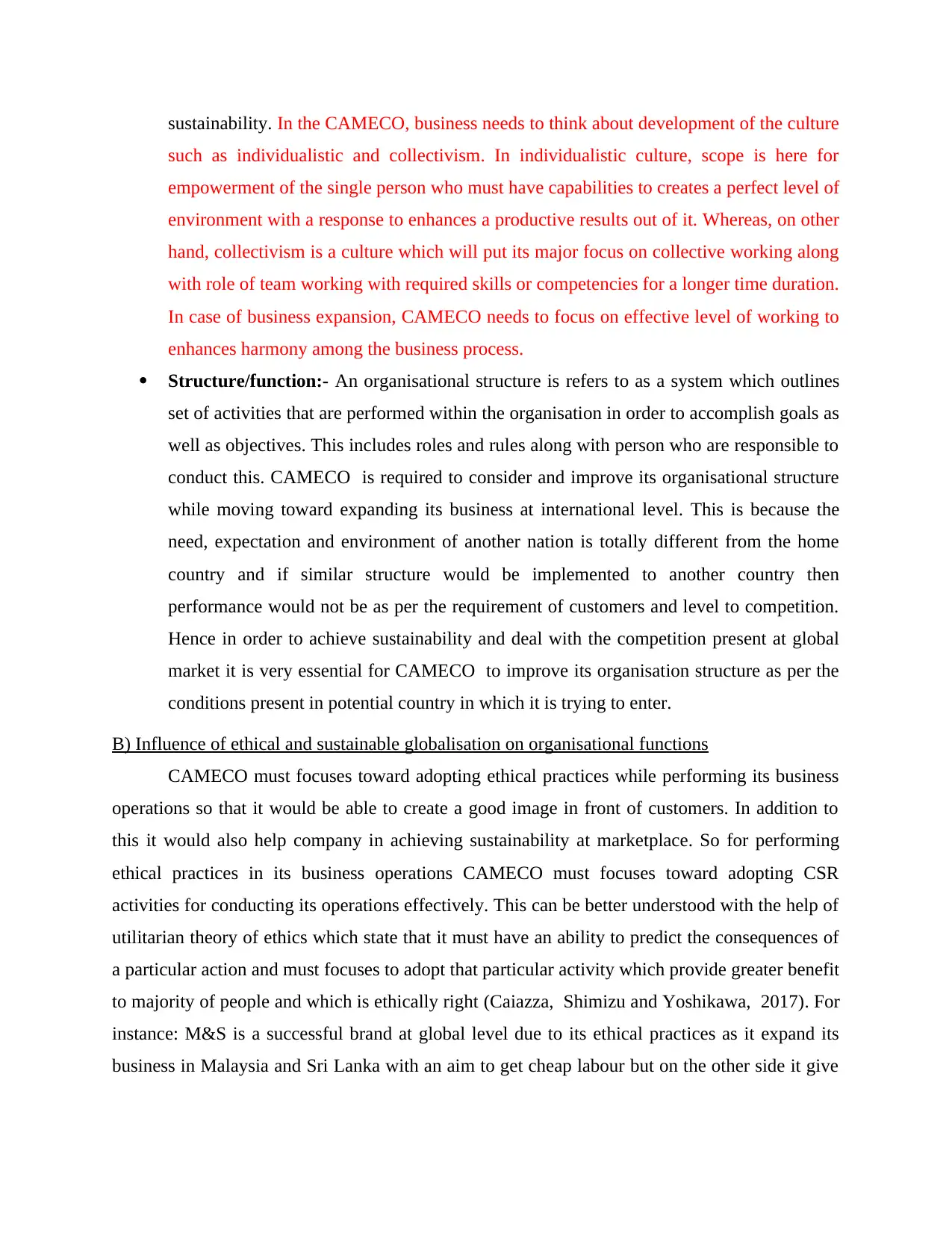
sustainability. In the CAMECO, business needs to think about development of the culture
such as individualistic and collectivism. In individualistic culture, scope is here for
empowerment of the single person who must have capabilities to creates a perfect level of
environment with a response to enhances a productive results out of it. Whereas, on other
hand, collectivism is a culture which will put its major focus on collective working along
with role of team working with required skills or competencies for a longer time duration.
In case of business expansion, CAMECO needs to focus on effective level of working to
enhances harmony among the business process.
Structure/function:- An organisational structure is refers to as a system which outlines
set of activities that are performed within the organisation in order to accomplish goals as
well as objectives. This includes roles and rules along with person who are responsible to
conduct this. CAMECO is required to consider and improve its organisational structure
while moving toward expanding its business at international level. This is because the
need, expectation and environment of another nation is totally different from the home
country and if similar structure would be implemented to another country then
performance would not be as per the requirement of customers and level to competition.
Hence in order to achieve sustainability and deal with the competition present at global
market it is very essential for CAMECO to improve its organisation structure as per the
conditions present in potential country in which it is trying to enter.
B) Influence of ethical and sustainable globalisation on organisational functions
CAMECO must focuses toward adopting ethical practices while performing its business
operations so that it would be able to create a good image in front of customers. In addition to
this it would also help company in achieving sustainability at marketplace. So for performing
ethical practices in its business operations CAMECO must focuses toward adopting CSR
activities for conducting its operations effectively. This can be better understood with the help of
utilitarian theory of ethics which state that it must have an ability to predict the consequences of
a particular action and must focuses to adopt that particular activity which provide greater benefit
to majority of people and which is ethically right (Caiazza, Shimizu and Yoshikawa, 2017). For
instance: M&S is a successful brand at global level due to its ethical practices as it expand its
business in Malaysia and Sri Lanka with an aim to get cheap labour but on the other side it give
such as individualistic and collectivism. In individualistic culture, scope is here for
empowerment of the single person who must have capabilities to creates a perfect level of
environment with a response to enhances a productive results out of it. Whereas, on other
hand, collectivism is a culture which will put its major focus on collective working along
with role of team working with required skills or competencies for a longer time duration.
In case of business expansion, CAMECO needs to focus on effective level of working to
enhances harmony among the business process.
Structure/function:- An organisational structure is refers to as a system which outlines
set of activities that are performed within the organisation in order to accomplish goals as
well as objectives. This includes roles and rules along with person who are responsible to
conduct this. CAMECO is required to consider and improve its organisational structure
while moving toward expanding its business at international level. This is because the
need, expectation and environment of another nation is totally different from the home
country and if similar structure would be implemented to another country then
performance would not be as per the requirement of customers and level to competition.
Hence in order to achieve sustainability and deal with the competition present at global
market it is very essential for CAMECO to improve its organisation structure as per the
conditions present in potential country in which it is trying to enter.
B) Influence of ethical and sustainable globalisation on organisational functions
CAMECO must focuses toward adopting ethical practices while performing its business
operations so that it would be able to create a good image in front of customers. In addition to
this it would also help company in achieving sustainability at marketplace. So for performing
ethical practices in its business operations CAMECO must focuses toward adopting CSR
activities for conducting its operations effectively. This can be better understood with the help of
utilitarian theory of ethics which state that it must have an ability to predict the consequences of
a particular action and must focuses to adopt that particular activity which provide greater benefit
to majority of people and which is ethically right (Caiazza, Shimizu and Yoshikawa, 2017). For
instance: M&S is a successful brand at global level due to its ethical practices as it expand its
business in Malaysia and Sri Lanka with an aim to get cheap labour but on the other side it give
Paraphrase This Document
Need a fresh take? Get an instant paraphrase of this document with our AI Paraphraser
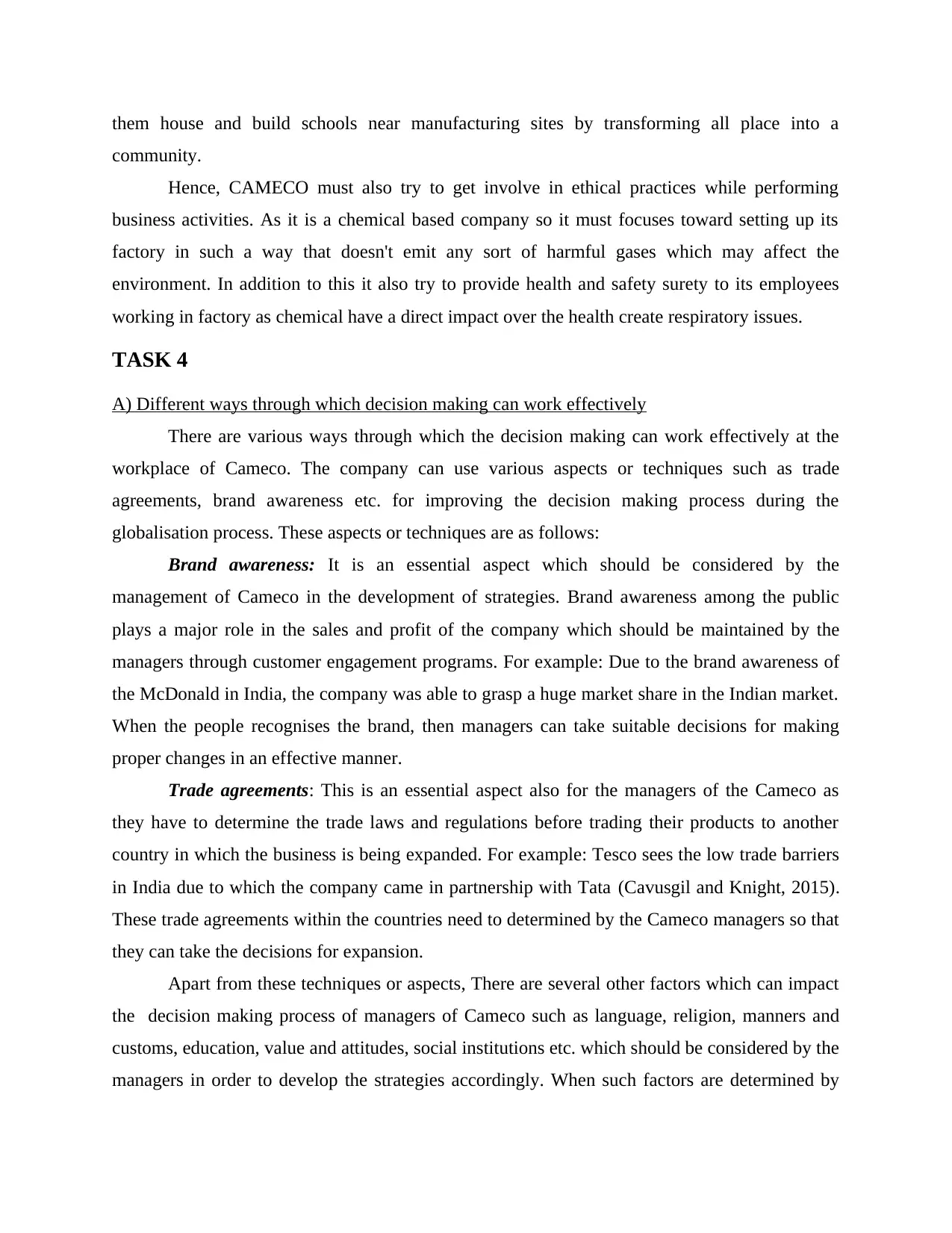
them house and build schools near manufacturing sites by transforming all place into a
community.
Hence, CAMECO must also try to get involve in ethical practices while performing
business activities. As it is a chemical based company so it must focuses toward setting up its
factory in such a way that doesn't emit any sort of harmful gases which may affect the
environment. In addition to this it also try to provide health and safety surety to its employees
working in factory as chemical have a direct impact over the health create respiratory issues.
TASK 4
A) Different ways through which decision making can work effectively
There are various ways through which the decision making can work effectively at the
workplace of Cameco. The company can use various aspects or techniques such as trade
agreements, brand awareness etc. for improving the decision making process during the
globalisation process. These aspects or techniques are as follows:
Brand awareness: It is an essential aspect which should be considered by the
management of Cameco in the development of strategies. Brand awareness among the public
plays a major role in the sales and profit of the company which should be maintained by the
managers through customer engagement programs. For example: Due to the brand awareness of
the McDonald in India, the company was able to grasp a huge market share in the Indian market.
When the people recognises the brand, then managers can take suitable decisions for making
proper changes in an effective manner.
Trade agreements: This is an essential aspect also for the managers of the Cameco as
they have to determine the trade laws and regulations before trading their products to another
country in which the business is being expanded. For example: Tesco sees the low trade barriers
in India due to which the company came in partnership with Tata (Cavusgil and Knight, 2015).
These trade agreements within the countries need to determined by the Cameco managers so that
they can take the decisions for expansion.
Apart from these techniques or aspects, There are several other factors which can impact
the decision making process of managers of Cameco such as language, religion, manners and
customs, education, value and attitudes, social institutions etc. which should be considered by the
managers in order to develop the strategies accordingly. When such factors are determined by
community.
Hence, CAMECO must also try to get involve in ethical practices while performing
business activities. As it is a chemical based company so it must focuses toward setting up its
factory in such a way that doesn't emit any sort of harmful gases which may affect the
environment. In addition to this it also try to provide health and safety surety to its employees
working in factory as chemical have a direct impact over the health create respiratory issues.
TASK 4
A) Different ways through which decision making can work effectively
There are various ways through which the decision making can work effectively at the
workplace of Cameco. The company can use various aspects or techniques such as trade
agreements, brand awareness etc. for improving the decision making process during the
globalisation process. These aspects or techniques are as follows:
Brand awareness: It is an essential aspect which should be considered by the
management of Cameco in the development of strategies. Brand awareness among the public
plays a major role in the sales and profit of the company which should be maintained by the
managers through customer engagement programs. For example: Due to the brand awareness of
the McDonald in India, the company was able to grasp a huge market share in the Indian market.
When the people recognises the brand, then managers can take suitable decisions for making
proper changes in an effective manner.
Trade agreements: This is an essential aspect also for the managers of the Cameco as
they have to determine the trade laws and regulations before trading their products to another
country in which the business is being expanded. For example: Tesco sees the low trade barriers
in India due to which the company came in partnership with Tata (Cavusgil and Knight, 2015).
These trade agreements within the countries need to determined by the Cameco managers so that
they can take the decisions for expansion.
Apart from these techniques or aspects, There are several other factors which can impact
the decision making process of managers of Cameco such as language, religion, manners and
customs, education, value and attitudes, social institutions etc. which should be considered by the
managers in order to develop the strategies accordingly. When such factors are determined by
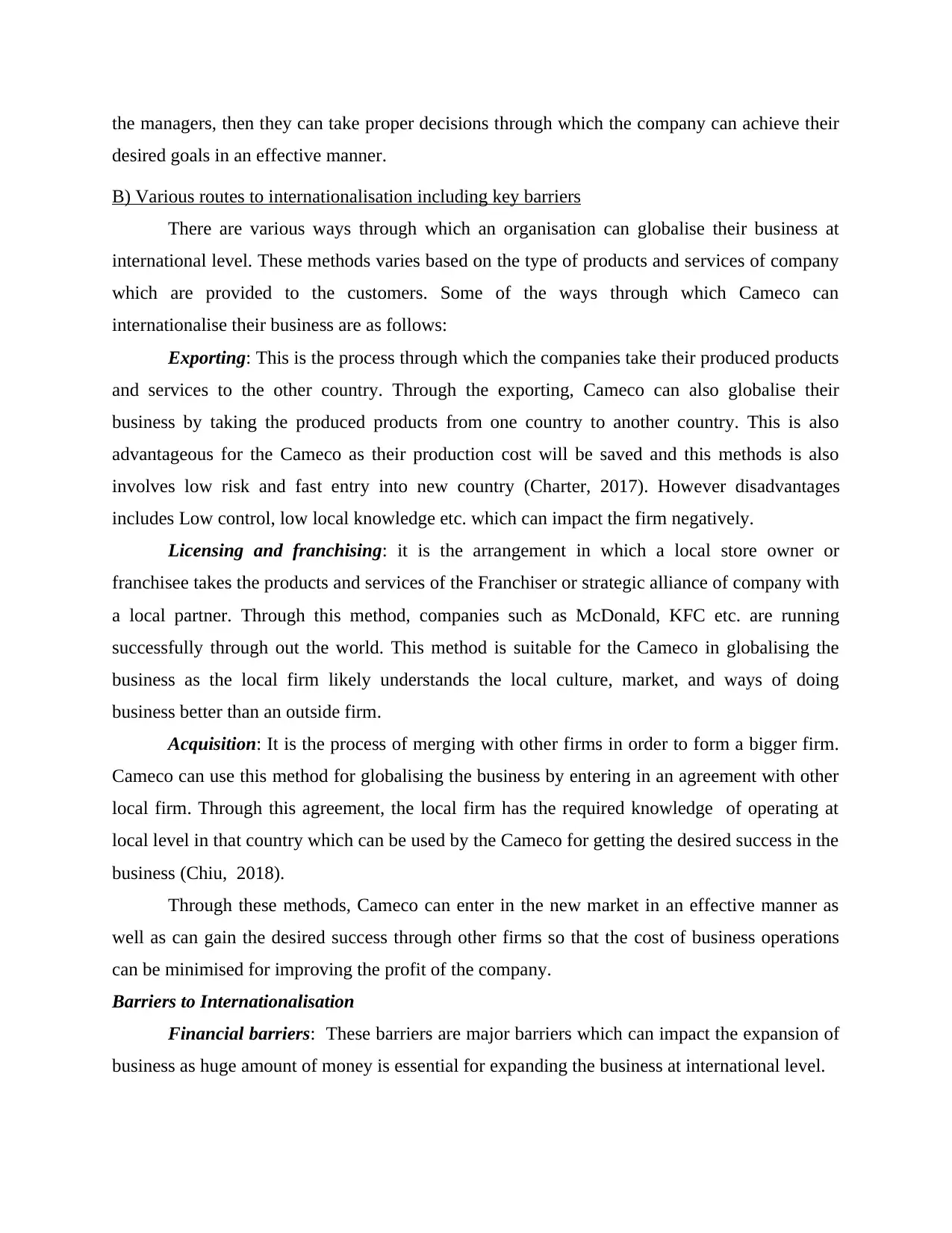
the managers, then they can take proper decisions through which the company can achieve their
desired goals in an effective manner.
B) Various routes to internationalisation including key barriers
There are various ways through which an organisation can globalise their business at
international level. These methods varies based on the type of products and services of company
which are provided to the customers. Some of the ways through which Cameco can
internationalise their business are as follows:
Exporting: This is the process through which the companies take their produced products
and services to the other country. Through the exporting, Cameco can also globalise their
business by taking the produced products from one country to another country. This is also
advantageous for the Cameco as their production cost will be saved and this methods is also
involves low risk and fast entry into new country (Charter, 2017). However disadvantages
includes Low control, low local knowledge etc. which can impact the firm negatively.
Licensing and franchising: it is the arrangement in which a local store owner or
franchisee takes the products and services of the Franchiser or strategic alliance of company with
a local partner. Through this method, companies such as McDonald, KFC etc. are running
successfully through out the world. This method is suitable for the Cameco in globalising the
business as the local firm likely understands the local culture, market, and ways of doing
business better than an outside firm.
Acquisition: It is the process of merging with other firms in order to form a bigger firm.
Cameco can use this method for globalising the business by entering in an agreement with other
local firm. Through this agreement, the local firm has the required knowledge of operating at
local level in that country which can be used by the Cameco for getting the desired success in the
business (Chiu, 2018).
Through these methods, Cameco can enter in the new market in an effective manner as
well as can gain the desired success through other firms so that the cost of business operations
can be minimised for improving the profit of the company.
Barriers to Internationalisation
Financial barriers: These barriers are major barriers which can impact the expansion of
business as huge amount of money is essential for expanding the business at international level.
desired goals in an effective manner.
B) Various routes to internationalisation including key barriers
There are various ways through which an organisation can globalise their business at
international level. These methods varies based on the type of products and services of company
which are provided to the customers. Some of the ways through which Cameco can
internationalise their business are as follows:
Exporting: This is the process through which the companies take their produced products
and services to the other country. Through the exporting, Cameco can also globalise their
business by taking the produced products from one country to another country. This is also
advantageous for the Cameco as their production cost will be saved and this methods is also
involves low risk and fast entry into new country (Charter, 2017). However disadvantages
includes Low control, low local knowledge etc. which can impact the firm negatively.
Licensing and franchising: it is the arrangement in which a local store owner or
franchisee takes the products and services of the Franchiser or strategic alliance of company with
a local partner. Through this method, companies such as McDonald, KFC etc. are running
successfully through out the world. This method is suitable for the Cameco in globalising the
business as the local firm likely understands the local culture, market, and ways of doing
business better than an outside firm.
Acquisition: It is the process of merging with other firms in order to form a bigger firm.
Cameco can use this method for globalising the business by entering in an agreement with other
local firm. Through this agreement, the local firm has the required knowledge of operating at
local level in that country which can be used by the Cameco for getting the desired success in the
business (Chiu, 2018).
Through these methods, Cameco can enter in the new market in an effective manner as
well as can gain the desired success through other firms so that the cost of business operations
can be minimised for improving the profit of the company.
Barriers to Internationalisation
Financial barriers: These barriers are major barriers which can impact the expansion of
business as huge amount of money is essential for expanding the business at international level.
You're viewing a preview
Unlock full access by subscribing today!
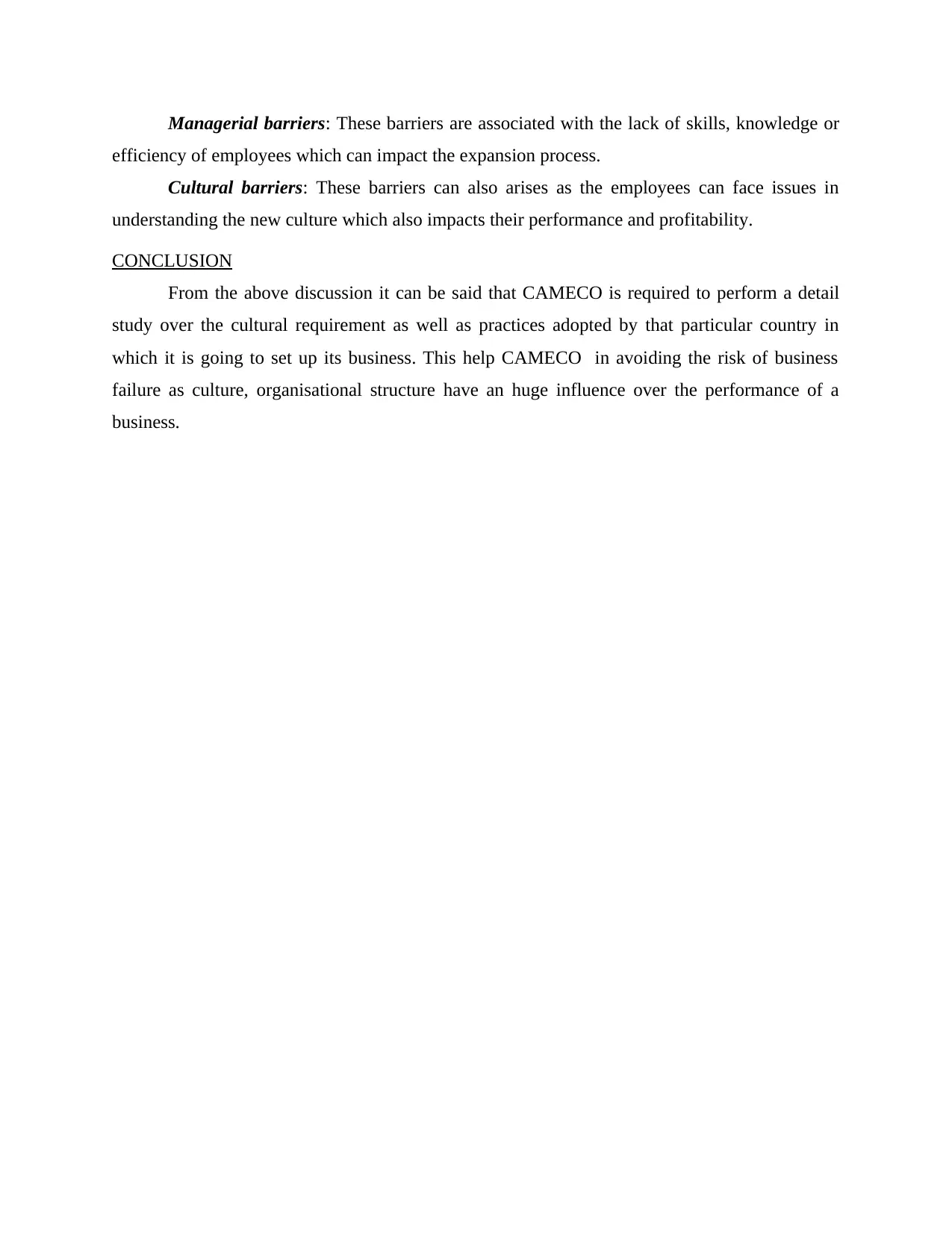
Managerial barriers: These barriers are associated with the lack of skills, knowledge or
efficiency of employees which can impact the expansion process.
Cultural barriers: These barriers can also arises as the employees can face issues in
understanding the new culture which also impacts their performance and profitability.
CONCLUSION
From the above discussion it can be said that CAMECO is required to perform a detail
study over the cultural requirement as well as practices adopted by that particular country in
which it is going to set up its business. This help CAMECO in avoiding the risk of business
failure as culture, organisational structure have an huge influence over the performance of a
business.
efficiency of employees which can impact the expansion process.
Cultural barriers: These barriers can also arises as the employees can face issues in
understanding the new culture which also impacts their performance and profitability.
CONCLUSION
From the above discussion it can be said that CAMECO is required to perform a detail
study over the cultural requirement as well as practices adopted by that particular country in
which it is going to set up its business. This help CAMECO in avoiding the risk of business
failure as culture, organisational structure have an huge influence over the performance of a
business.
Paraphrase This Document
Need a fresh take? Get an instant paraphrase of this document with our AI Paraphraser
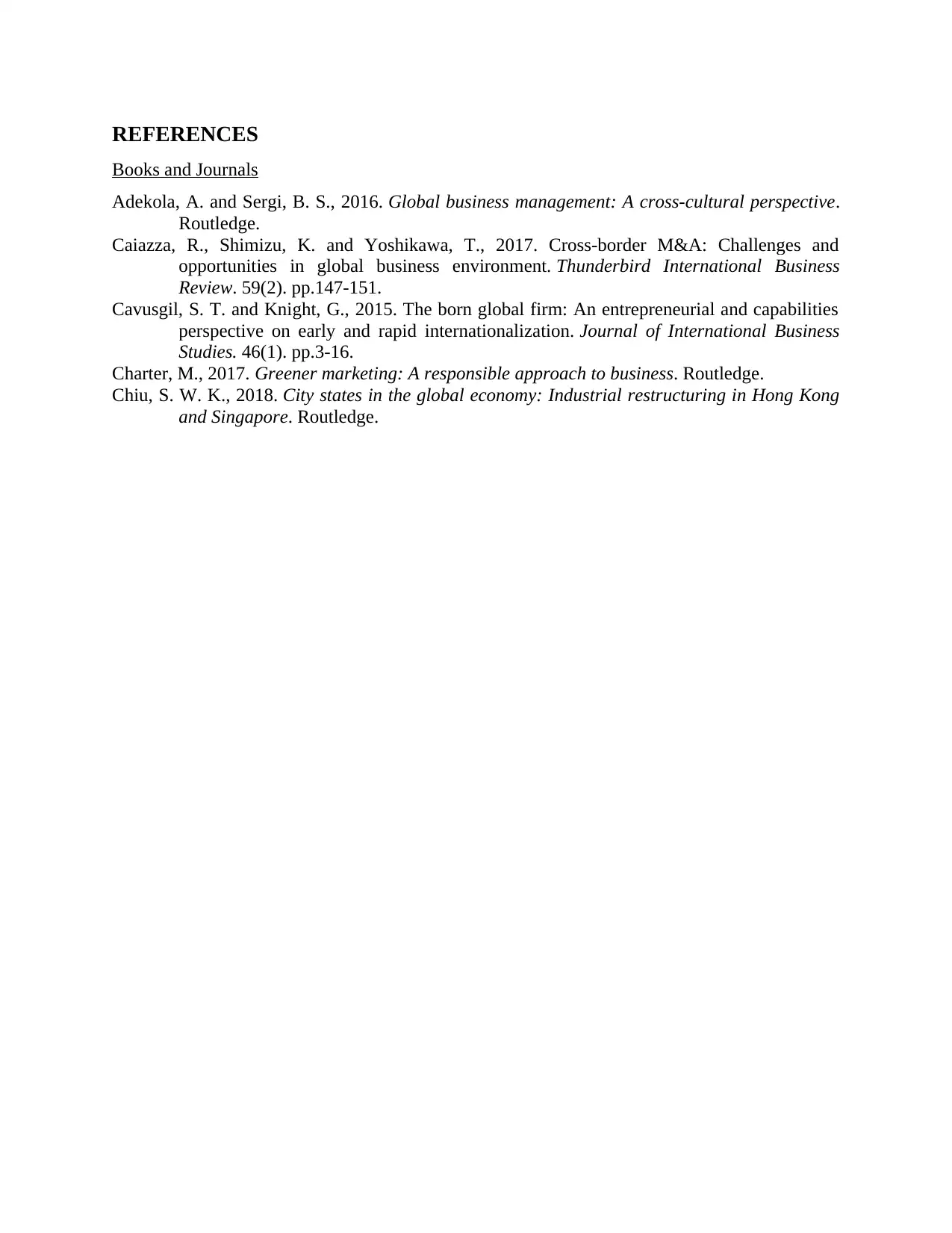
REFERENCES
Books and Journals
Adekola, A. and Sergi, B. S., 2016. Global business management: A cross-cultural perspective.
Routledge.
Caiazza, R., Shimizu, K. and Yoshikawa, T., 2017. Cross‐border M&A: Challenges and
opportunities in global business environment. Thunderbird International Business
Review. 59(2). pp.147-151.
Cavusgil, S. T. and Knight, G., 2015. The born global firm: An entrepreneurial and capabilities
perspective on early and rapid internationalization. Journal of International Business
Studies. 46(1). pp.3-16.
Charter, M., 2017. Greener marketing: A responsible approach to business. Routledge.
Chiu, S. W. K., 2018. City states in the global economy: Industrial restructuring in Hong Kong
and Singapore. Routledge.
Books and Journals
Adekola, A. and Sergi, B. S., 2016. Global business management: A cross-cultural perspective.
Routledge.
Caiazza, R., Shimizu, K. and Yoshikawa, T., 2017. Cross‐border M&A: Challenges and
opportunities in global business environment. Thunderbird International Business
Review. 59(2). pp.147-151.
Cavusgil, S. T. and Knight, G., 2015. The born global firm: An entrepreneurial and capabilities
perspective on early and rapid internationalization. Journal of International Business
Studies. 46(1). pp.3-16.
Charter, M., 2017. Greener marketing: A responsible approach to business. Routledge.
Chiu, S. W. K., 2018. City states in the global economy: Industrial restructuring in Hong Kong
and Singapore. Routledge.
1 out of 8
Related Documents
Your All-in-One AI-Powered Toolkit for Academic Success.
+13062052269
info@desklib.com
Available 24*7 on WhatsApp / Email
![[object Object]](/_next/static/media/star-bottom.7253800d.svg)
Unlock your academic potential
© 2024 | Zucol Services PVT LTD | All rights reserved.





